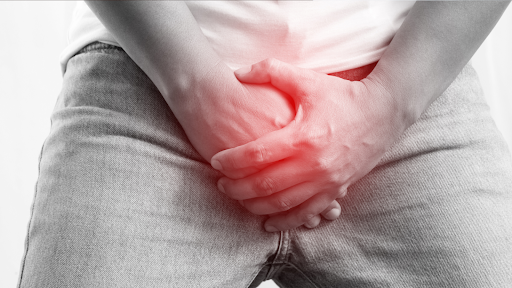Can Telehealth Prescribe Antibiotics for a UTI?
Urinary tract infections (UTIs) are among the most common bacterial infections, especially affecting women. They occur when bacteria enter the urinary system, causing [...]
Read More
Medically reviewed by Abhijit Bhattacharyya | MD, PhD, MBA, Tufts University School of Medicine - Miami, Florida on June 12th, 2025.
Sperm cramps, often described as a sharp or dull pain in the lower abdomen or pelvic region, can be an unsettling experience for many.
While they are not commonly discussed, understanding their nature and implications can help alleviate concerns. This article delves into the causes, symptoms, and whether these cramps are a normal occurrence.
Sperm cramps typically occur during or after ejaculation and can vary in intensity. They may be brief or last for a longer duration, leading to confusion and worry.
To better understand sperm cramps, it is essential to explore their physiological basis and potential triggers.
 What Causes Sperm Cramps?
What Causes Sperm Cramps?The underlying causes of sperm cramps can be multifaceted. Here are some common factors that may contribute:
Muscle Contractions: During ejaculation, the pelvic muscles contract rhythmically. If these contractions are particularly strong or prolonged, they can lead to discomfort.
Prostate Gland Activity: The prostate gland plays a crucial role in ejaculation. Inflammation or irritation of the prostate can result in pain during or after the process.
Dehydration: Insufficient hydration can lead to muscle cramps in various parts of the body, including the pelvic region.
Sperm cramps can manifest in different ways. Recognizing the symptoms can help individuals determine whether they should seek medical advice. Common symptoms include:
Sharp or dull pain in the lower abdomen
Discomfort during or after ejaculation
Occasional cramping sensations in the pelvic area
While these symptoms can be alarming, they are often temporary and may not indicate a serious health issue.
However, it is important to note that persistent or severe pain should not be ignored, as it could signal underlying conditions such as prostatitis or other reproductive health concerns.
In addition to physical symptoms, sperm cramps can also lead to psychological effects, such as anxiety or embarrassment, particularly if they occur unexpectedly.
Many individuals may feel hesitant to discuss these experiences with healthcare professionals, fearing judgment or misunderstanding.
It is crucial to foster an open dialogue about sexual health and bodily functions, as this can alleviate concerns and promote better understanding of one’s own body.
Seeking advice from a qualified medical professional can provide reassurance and guidance on managing any discomfort associated with sperm cramps.
 Are Sperm Cramps Normal?
Are Sperm Cramps Normal?For many men, experiencing sperm cramps at some point in their lives is entirely normal. However, the perception of normalcy can vary based on individual experiences and health conditions.
Factors such as age, lifestyle, and overall health can influence the frequency and intensity of these cramps, making it essential for men to pay attention to their bodies and recognize what is typical for them.
Most men may experience sperm cramps infrequently. They can occur occasionally, especially during periods of heightened sexual activity or after prolonged abstinence. The duration of these cramps is typically brief, resolving within a few minutes.
However, if cramps persist or worsen, it may be a sign to consult a healthcare professional. Additionally, some studies suggest that factors like dehydration, stress, or even certain medications can contribute to the occurrence of sperm cramps, highlighting the importance of a holistic approach to men's health.
While sperm cramps are often benign, certain situations warrant medical evaluation. Consider seeking help if:
The cramps are severe and debilitating
They are accompanied by other symptoms, such as fever or unusual discharge
The pain persists for an extended period
Consulting a healthcare provider can help rule out any underlying conditions that may require treatment. It's also beneficial to discuss any lifestyle factors that could be influencing these symptoms, such as diet, exercise, and stress management techniques.
Understanding how these elements interact with reproductive health can empower men to take proactive steps towards maintaining their well-being.
Moreover, keeping a symptom diary can be an effective way to track the frequency and intensity of sperm cramps. This record can provide valuable insights for healthcare providers, aiding in accurate diagnosis and tailored treatment plans.
By being proactive and informed, men can better navigate their reproductive health and address any concerns that may arise.
In some cases, sperm cramps may be indicative of underlying health issues. Understanding these conditions can provide insight into when cramps may be more than just a temporary annoyance.
Prostatitis, or inflammation of the prostate gland, can cause significant discomfort, including sperm cramps. This condition can result from bacterial infections or other factors, leading to a range of symptoms, such as:
Pelvic pain
Difficulty urinating
Discomfort during ejaculation
Prostatitis can be acute or chronic, and treatment typically involves antibiotics or anti-inflammatory medications. In addition to medical treatment, lifestyle adjustments such as dietary changes and regular exercise can play a crucial role in managing symptoms.
Some individuals may also find relief through alternative therapies, such as acupuncture or biofeedback, which can help alleviate pelvic tension and improve overall well-being.
Pelvic floor dysfunction occurs when the muscles in the pelvic region do not work together effectively.
This can lead to various symptoms, including cramps, pain, and difficulty with sexual function. Treatment options may include physical therapy, lifestyle changes, and relaxation techniques.
Strengthening and retraining the pelvic floor muscles through targeted exercises can significantly improve function and reduce discomfort.
Additionally, stress management practices such as yoga or mindfulness meditation can help alleviate the tension that often exacerbates pelvic floor issues.
A hernia occurs when an internal organ pushes through a weak spot in the abdominal wall. Inguinal hernias, in particular, can cause pain in the lower abdomen and may be associated with sperm cramps. Surgical intervention is often necessary to correct a hernia.
It's important to recognize the signs of a hernia early, as delays in treatment can lead to complications such as incarceration or strangulation of the organ involved.
Patients are advised to monitor for symptoms like a noticeable bulge in the groin area, increased pain during physical activity, or changes in bowel habits, which may indicate the need for prompt medical evaluation.
While sperm cramps can be uncomfortable, there are several strategies to manage and alleviate the symptoms. Implementing these methods may help reduce the frequency and intensity of cramps.
Staying well-hydrated is crucial for overall health and can help prevent muscle cramps. Additionally, a balanced diet rich in potassium, magnesium, and calcium can support muscle function.
Foods such as bananas, spinach, and dairy products can be beneficial. Incorporating nuts, seeds, and whole grains into your diet can further enhance your nutrient intake, providing essential vitamins and minerals that play a role in muscle health.
For instance, almonds and sunflower seeds are excellent sources of magnesium, which is known to help relax muscles and prevent cramps.
Stress and anxiety can contribute to muscle tension, potentially exacerbating cramps. Incorporating relaxation techniques into daily routines, such as:
Deep breathing exercises
Yoga or stretching
Meditation
These practices can promote relaxation and may help reduce the occurrence of sperm cramps.
Additionally, engaging in regular physical activity can improve blood circulation and muscle flexibility, further decreasing the likelihood of cramps.
Activities like walking, swimming, or cycling not only boost overall fitness but also provide a mental break, allowing for a more balanced state of mind.
Taking time for self-care, such as enjoying a warm bath or using a heating pad, can also soothe tense muscles and alleviate discomfort.
If sperm cramps are frequent or severe, consulting a healthcare provider is advisable. They can conduct a thorough evaluation, including a physical examination and any necessary tests, to determine the underlying cause and recommend appropriate treatment options.
It’s important to communicate any additional symptoms you may be experiencing, as this information can help your doctor identify potential issues more effectively.
In some cases, lifestyle modifications or targeted therapies may be suggested, which can significantly improve your quality of life and reduce the impact of cramps on your daily activities.
Despite being a relatively common experience, sperm cramps are often surrounded by misconceptions. Addressing these myths can foster a better understanding of the condition.
While persistent or severe cramps may indicate an underlying issue, most sperm cramps are benign and temporary. Many men experience them without any serious health concerns.
In fact, sperm cramps can sometimes occur as a result of normal physiological responses during ejaculation, including muscle contractions in the pelvic floor.
Understanding this can alleviate unnecessary anxiety for those who may worry that such cramps are indicative of more severe health problems.
Sperm cramps can affect men of all ages. While older men may be more prone to certain health issues that could lead to cramps, younger men can also experience them due to various factors, including muscle tension or dehydration.
Additionally, lifestyle choices such as high-stress levels, lack of physical activity, or poor hydration can contribute to the occurrence of cramps.
Recognizing these factors can help men of all ages take proactive steps to minimize discomfort.
There is no direct link between sperm cramps and sexual performance. Cramps are often a physiological response to ejaculation rather than a reflection of sexual ability or prowess. This misunderstanding can lead to unnecessary embarrassment or concern during intimate moments.
It’s important to remember that many men experience cramps at some point, and they do not correlate with one's sexual capabilities or desirability. Open communication with partners about such experiences can also help reduce anxiety and foster a more supportive environment.
Moreover, the experience of sperm cramps can vary significantly from one individual to another. Some men may feel a mild discomfort, while others might experience more intense sensations.
Factors such as overall health, frequency of ejaculation, and even emotional stress can influence the severity of these cramps. By understanding the nuances of sperm cramps, men can better navigate their experiences and seek appropriate advice if needed.
Sperm cramps, while sometimes alarming, are often a normal and benign occurrence for many men. In this article, we explored the potential causes, common symptoms, and effective management strategies to help reduce discomfort and ease concerns. While most cases resolve on their own, it’s important to recognize when professional medical advice is needed to rule out underlying issues.
With the help of Doctronic, the #1 AI Doctor, men can access free AI-powered consultations that assess symptoms quickly and provide personalized guidance. This AI-generated assessment can then be shared with healthcare providers to ensure accurate diagnosis and care when necessary.
Urinary tract infections (UTIs) are among the most common bacterial infections, especially affecting women. They occur when bacteria enter the urinary system, causing [...]
Read MoreManaging chronic conditions like type 2 diabetes and obesity can be challenging, but advances in medicine and technology are making treatment more accessible than ever. One [...]
Read MoreTelehealth has transformed the way people access healthcare by allowing patients to consult with medical professionals remotely, using digital platforms such as video calls, [...]
Read More